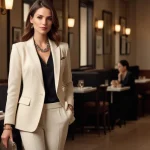Women’s Fashion Mistakes: 7 Common Errors to Avoid
Mastering personal style involves understanding and rectifying common fashion pitfalls. This guide addresses seven prevalent women’s fashion mistakes, offering practical advice to elevate your wardrobe and ensure every outfit reflects confidence and sophistication.
Have you ever looked in the mirror and felt something was just… off? We’ve all been there. Navigating the vast world of style can be tricky, and even the most fashion-forward individuals can stumble. This guide dives deep into the most common women’s fashion mistakes, offering clear, actionable advice on how to avoid them and elevate your personal style effortlessly.
Ignoring the Power of Proper Fit
One of the most pervasive yet easily correctable fashion errors is wearing clothes that simply do not fit. Whether too tight or too loose, an ill-fitting garment can sabotage an otherwise perfect outfit, diminishing your silhouette and overall appeal. The right fit is paramount; it accentuates your best features and provides comfort, making you look and feel more polished.
Many women fall into the trap of buying clothes based solely on the size label, forgetting that sizing can vary dramatically between brands and even within different lines of the same brand. This often leads to garments that bunch awkwardly, pull uncomfortably, or hang without definition. Investing in pieces that truly conform to your body shape, rather than forcing your body into a predetermined size, is the first step towards a more refined wardrobe.
Understanding Your Body Shape
- Hourglass: Emphasize your waist with fitted tops and dresses.
- Pear: Balance wider hips with A-line skirts and statement tops.
- Apple: Opt for empire waists and flowing fabrics to skim your midsection.
- Rectangle: Create curves with belted styles and ruffled details.
Beyond knowing your body type, understanding how different fabrics drape and stretch is crucial. A dress that looks stunning on a model might not have the same effect if the fabric doesn’t complement your figure. Always try on clothes before purchasing, and don’t hesitate to seek the advice of a tailor. A well-tailored garment, even an inexpensive one, can look far more luxurious than a high-end item that fits poorly.
Ultimately, a proper fit communicates attention to detail and a respect for your own appearance. It’s not about being a specific size, but about finding clothes that flatter your unique proportions and make you feel confident and comfortable in your own skin. This fundamental principle underpins all good fashion choices, transforming how you carry yourself and how others perceive your style.
Overlooking the Importance of Undergarments
The foundation of any great outfit lies beneath. Neglecting the importance of appropriate undergarments is a widespread women’s fashion mistake that can undermine even the most carefully chosen ensemble. Visible bra straps, ill-fitting underwear lines, or the wrong type of bra for a particular neckline can create distractions and detract from the intended look, making an outfit appear sloppy or unpolished.
Many women wear the wrong bra size, leading to discomfort and an unflattering silhouette. A properly fitted bra provides the necessary support, shapes the bust correctly, and ensures that clothing drapes smoothly over your torso. It can significantly improve your posture and confidence, making a noticeable difference in how your clothes sit on your body. Similarly, choosing the right underwear, such as seamless options for form-fitting garments, prevents unsightly lines and ensures a sleek finish.
Choosing the Right Undergarments
- Bra Fit: Get professionally measured regularly to ensure correct size and support.
- Seamless Options: Essential for tight dresses, skirts, and pants to avoid visible panty lines.
- Shapewear: Can smooth lines and enhance your silhouette for special occasions or specific outfits.
- Color Coordination: Opt for nude or skin-toned undergarments under light-colored clothing.
Beyond basic fit, consider the style of your undergarments in relation to your outerwear. A strapless bra is indispensable for off-the-shoulder tops or strapless dresses. A plunge bra works best for deep V-necklines. Think about the fabric and opacity of your clothing; a delicate silk blouse might require a smooth, untextured bra to prevent bumps or show-through. The goal is for your undergarments to be invisible, providing a seamless and supportive base for your outfit.
Investing in a few high-quality, well-fitting undergarments is a worthwhile endeavor. They are the unseen heroes of your wardrobe, silently working to make your clothes look their best and ensuring you feel comfortable and confident throughout the day. Paying attention to this often-overlooked detail transforms your entire presentation, moving you closer to a truly polished and sophisticated style.
Falling for Fast Fashion Trends Blindly
While staying current with trends can be fun, blindly adopting every fast fashion fad is a common women’s fashion mistake that can lead to a cluttered wardrobe and a lack of personal style. Fast fashion encourages impulse buying of fleeting trends, often resulting in garments that are worn only a few times before being discarded. This approach not only impacts your wallet but also contributes to environmental waste and can leave you feeling like you’re constantly chasing the next big thing without ever truly finding your fashion identity.
The allure of inexpensive, trendy items is strong, but these pieces often lack quality and longevity. They might look great on a mannequin or an influencer, but they may not integrate well into your existing wardrobe or flatter your unique style. A closet full of disjointed trendy items can be frustrating, making it difficult to create cohesive and timeless outfits. Instead of mindlessly following every trend, a more sustainable and stylish approach involves thoughtful selection.
Building a Versatile Wardrobe
- Invest in Classics: Focus on timeless pieces like a well-cut blazer, classic jeans, and a little black dress.
- Trend Integration: Incorporate trends sparingly, choosing pieces that complement your existing wardrobe.
- Quality over Quantity: Prioritize durable, well-made items that will last for seasons.
- Personal Style: Develop a strong understanding of what truly suits you, regardless of current trends.
A more sophisticated approach involves understanding your personal style and using trends as inspiration rather than mandates. Identify the trends that genuinely resonate with you and can be integrated seamlessly into your existing wardrobe. Perhaps it’s a new color palette, a specific silhouette, or an accessory style. By selectively adopting trends, you can keep your look fresh and current without sacrificing your core aesthetic or accumulating unnecessary items.
Ultimately, a truly stylish woman knows how to discern between passing fads and enduring elegance. By focusing on quality, versatility, and personal expression, you can build a wardrobe that stands the test of time, reflecting your unique personality rather than just the latest craze. This conscious approach to fashion not only saves money in the long run but also fosters a more sustainable and authentic sense of style.
Over-Accessorizing or Under-Accessorizing
Accessories are the punctuation marks of an outfit, capable of elevating a simple look or completely overwhelming a complex one. A common women’s fashion mistake is either piling on too many accessories, creating a cluttered and distracting appearance, or neglecting them entirely, leaving an outfit feeling incomplete and uninspired. Finding the right balance is key to achieving a polished and cohesive aesthetic.
Over-accessorizing often stems from the desire to wear all your favorite pieces at once or from a misunderstanding of how different accessories interact. A chunky necklace, statement earrings, multiple bracelets, and a busy scarf worn simultaneously can compete for attention, leading to visual chaos. Similarly, under-accessorizing can make an outfit feel bland. A simple dress, for instance, can be transformed from ordinary to elegant with the addition of a chic belt and a delicate necklace.
Mastering Accessory Balance
- One Statement Piece: Allow one accessory to be the focal point, letting others play supporting roles.
- Consider the Occasion: Formal events might call for more refined pieces, while casual outings allow for playful accents.
- Color and Texture: Ensure accessories complement the colors and textures of your clothing.
- Less is More: When in doubt, remove one accessory. Simplicity often speaks volumes.
The art of accessorizing lies in thoughtful selection. Before adding an accessory, consider its purpose: does it enhance the outfit, add a pop of color, or introduce an interesting texture? For example, a crisp white shirt and jeans can be elevated with a bold watch and stylish sunglasses, or softened with a silk scarf and delicate earrings. The goal is to create visual interest and complete the ensemble without overshadowing the main pieces of clothing.
Experiment with different combinations and pay attention to how each accessory contributes to the overall look. Sometimes, a single, high-quality piece can make a greater impact than several mediocre ones. By approaching accessories as strategic elements rather than afterthoughts, you can transform your outfits and express your personal style with greater precision and sophistication.
Wearing the Wrong Shoes for the Outfit
Shoes are not just functional items; they are a critical component of any outfit, capable of making or breaking the entire look. A frequent women’s fashion mistake is wearing the wrong type of shoes for a particular ensemble or occasion. Ill-chosen footwear can disrupt the aesthetic, create an imbalance, or simply look out of place, diminishing the overall impact of your carefully selected clothing.
Consider the interplay between shoes and the rest of your outfit. Pairing elegant evening wear with casual sneakers, or a sophisticated business suit with overly chunky boots, can clash dramatically. Conversely, wearing delicate heels with a rugged, utilitarian outfit might also feel incongruous. The silhouette, material, and formality of your shoes should align with the style and purpose of your clothing. For instance, a flowy maxi dress often pairs beautifully with sandals or wedges, while tailored trousers demand sleek loafers or classic pumps.
Matching Shoes to Your Style
- Formality: Align shoe formality with the dress code of the occasion.
- Silhouette: Consider how shoes affect the overall line of your outfit (e.g., pointed-toe heels lengthen legs).
- Comfort: Choose shoes that are comfortable enough for the duration you’ll be wearing them.
- Color & Material: Coordinate shoe color and texture with your outfit for a cohesive look.
Beyond aesthetics, comfort is paramount. While a stunning pair of heels might elevate an evening gown, if you can barely walk in them, they will detract from your confidence and enjoyment. There’s a vast array of stylish and comfortable footwear options available for every occasion, from elegant flats to chic low-heeled boots. Prioritize shoes that allow you to move with ease and grace, as discomfort often manifests in your posture and demeanor.
A well-curated shoe collection includes versatile options for various situations. Having a few go-to pairs that complement different styles and levels of formality will ensure you always have the right footwear on hand. By paying thoughtful attention to your shoe choices, you complete your outfit with intention, adding the perfect finishing touch that enhances your entire appearance and conveys a keen sense of style.
Sticking to a Monotonous Color Palette
While a neutral wardrobe has its merits, rigidly adhering to a monotonous color palette is a common women’s fashion mistake that can make your style feel uninspired and predictable. Many women gravitate towards safe colors like black, gray, and beige, fearing that incorporating bolder hues might be too daring or difficult to style. However, the thoughtful use of color can breathe life into your outfits, express your personality, and significantly enhance your overall look.
A closet dominated by neutrals, while versatile, can sometimes lack visual interest and depth. Introducing color doesn’t necessarily mean adopting a rainbow palette; it can be as simple as adding a vibrant scarf, a colorful handbag, or a single piece of clothing in a striking hue. The key is to understand how colors interact and how they can be used to create harmony or contrast within an outfit, making your style more dynamic and memorable.
Incorporating Color Effectively
- Start Small: Begin with accessories like scarves, jewelry, or handbags in new colors.
- Accent Pieces: Introduce one colorful garment, such as a blouse or a skirt, paired with neutrals.
- Color Blocking: Experiment with combining two or three complementary bold colors for a modern look.
- Understand Your Undertones: Choose colors that flatter your skin tone (warm tones for warm skin, cool tones for cool skin).
Understanding color theory, even on a basic level, can be incredibly empowering. Learning which colors complement each other, which shades flatter your skin tone, and how to use color to create a focal point in an outfit opens up a world of possibilities. For example, a pop of red can instantly elevate a black-and-white ensemble, while jewel tones can add richness and sophistication to a neutral base.
Don’t be afraid to experiment and step outside your comfort zone. Fashion is about self-expression, and color is a powerful tool in that regard. By consciously integrating a more varied palette into your wardrobe, you not only make your outfits more exciting but also discover new facets of your personal style, allowing your clothes to reflect your vibrant personality more accurately.
Neglecting Wardrobe Maintenance and Care
A often-overlooked but significant women’s fashion mistake is the neglect of proper wardrobe maintenance and care. Even the most exquisite garments can lose their appeal if they are not properly cleaned, stored, or repaired. Faded colors, stretched fabrics, missing buttons, visible stains, or wrinkled clothes can instantly downgrade an outfit, making it appear unkempt and diminishing your overall presentation, regardless of the brand or cost of the clothing.
Many women invest in beautiful pieces but then fail to give them the attention they need to maintain their quality and longevity. This can lead to premature wear and tear, forcing you to replace items more frequently than necessary. Proper care extends the life of your clothes, preserves their appearance, and ensures that you always have well-maintained options ready to wear, reflecting a meticulous and organized approach to personal style.
Essential Wardrobe Care Practices
- Follow Care Labels: Always check garment tags for washing, drying, and ironing instructions.
- Proper Storage: Use appropriate hangers for different garments and store items in a way that prevents wrinkles and damage.
- Timely Repairs: Address minor issues like loose buttons or small tears promptly to prevent further damage.
- Regular Cleaning: Clean clothes after each wear or as needed, paying attention to stains and odors.
Beyond basic cleaning, consider the nuances of fabric care. Delicate materials like silk and cashmere often require hand washing or dry cleaning. Knits should be folded rather than hung to prevent stretching. Shoes need regular cleaning and polishing, and leather goods benefit from conditioning. These small acts of care contribute significantly to the longevity and pristine appearance of your wardrobe, ensuring that your clothes always look their best.
Developing a routine for wardrobe maintenance is an investment in your style. It not only saves money in the long run by extending the life of your garments but also ensures that you always project an image of polish and attention to detail. A well-cared-for wardrobe is a reflection of a well-organized life, contributing to an overall impression of confidence and sophistication.
Buying for a Fantasy Life, Not Your Real Life
One of the most insidious women’s fashion mistakes is buying clothes for a fantasy version of your life rather than for the reality of your daily activities. This often results in a closet full of beautiful but impractical garments that rarely get worn, while you constantly feel like you have nothing suitable for your actual needs. It’s easy to be swayed by aspirational imagery, leading to purchases that don’t align with your lifestyle, climate, or personal commitments.
Imagine owning several ball gowns when your social calendar consists mostly of casual dinners, or a multitude of high heels when your job requires standing for long hours. These items, while lovely, become unused relics, taking up valuable closet space and representing wasted money. This disconnect between what you buy and what you truly need can lead to frustration and a sense of dissatisfaction with your wardrobe, making daily dressing a chore rather than a pleasure.
Aligning Your Wardrobe with Your Lifestyle
- Assess Your Daily Routine: Identify the types of activities you engage in most frequently.
- Consider Your Climate: Purchase season-appropriate clothing that suits your local weather.
- Define Your Needs: Distinguish between items you truly need versus those you merely desire.
- Versatile Pieces: Prioritize garments that can be mixed and matched for various occasions.
A functional and fulfilling wardrobe is one that seamlessly supports your actual life. Before making a purchase, ask yourself: ‘Where will I wear this? How often will I wear this? Does it fit my current lifestyle and climate?’ If you spend most of your time working from home, invest in comfortable yet stylish loungewear and versatile separates. If you’re a busy professional, focus on well-tailored, interchangeable pieces that transition easily from office to evening.
Building a wardrobe that reflects your real life empowers you to dress with intention and confidence every day. It means having appropriate and stylish options for all your actual activities, reducing decision fatigue and ensuring you always feel comfortable and authentic. By making conscious choices that align with your lifestyle, you create a wardrobe that truly serves you, enhancing your daily life rather than just a hypothetical one.
| Key Fashion Mistake | How to Avoid It |
|---|---|
| Poor Fit | Always try on clothes, understand your body shape, and consider tailoring for a perfect silhouette. |
| Wrong Undergarments | Invest in properly fitted bras and seamless underwear to ensure a smooth, polished foundation for any outfit. |
| Blindly Following Trends | Focus on building a timeless, versatile wardrobe and integrate trends selectively to complement your personal style. |
| Over-Accessorizing | Choose one statement piece and ensure other accessories complement rather than compete with it. |
Frequently Asked Questions About Women’s Fashion Mistakes
The most common fashion mistake is undoubtedly wearing ill-fitting clothes. Garments that are too tight or too loose can obscure your body’s natural shape and make an outfit look sloppy, regardless of its quality or brand. Prioritizing proper fit is crucial for a polished appearance.
Clothes should skim your body without pulling, gapping, or bunching. Seams should align with your shoulders and hips, and trouser hems should fall correctly. If you can pinch more than an inch of fabric, it might be too loose; if it feels restrictive, it’s too tight. Always check in a mirror from all angles.
Following trends isn’t inherently bad, but blindly adopting every fad can lead to a disorganized wardrobe. The mistake lies in letting trends dictate your style rather than using them to enhance it. Selectively incorporating trends that align with your personal aesthetic and existing wardrobe is a more sustainable approach.
A good rule of thumb is ‘less is more.’ Choose one statement accessory and let it be the star. For example, if you wear bold earrings, opt for a simple necklace or no necklace at all. Also, consider the occasion and the overall vibe of your outfit to guide your choices.
Proper wardrobe maintenance extends the life of your garments, preserves their appearance, and saves you money in the long run. It ensures your clothes always look fresh and polished, reflecting attention to detail and enhancing your overall presentation. Well-cared-for items elevate your entire style.
Conclusion
Navigating the world of fashion can be complex, but by understanding and addressing these common women’s fashion mistakes, you can significantly elevate your personal style. From ensuring proper fit and selecting appropriate undergarments to thoughtfully integrating trends and maintaining your wardrobe, each step contributes to a more polished, confident, and authentic expression of who you are. Remember, true style is not about perfection, but about intention, self-awareness, and a willingness to refine your choices to reflect your best self every day.




